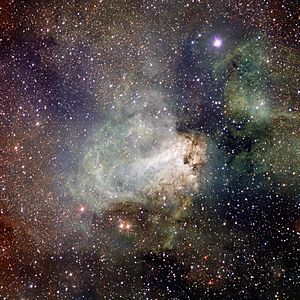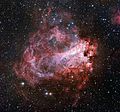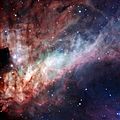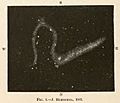Omega Nebula facts for kids
The Omega Nebula is a huge cloud of gas and dust far out in space. It's also called the Swan Nebula because of its shape. You might also hear it called the Horseshoe Nebula, Checkmark Nebula, or Lobster Nebula! This amazing space cloud is a place where new stars are being born.
It's located in the constellation of Sagittarius. That's about 5,500 light-years away from Earth. A light-year is how far light travels in one year. That's a really, really long distance!
A person named Philippe Loys de Chéseaux first saw the Omega Nebula in 1745. Later, in 1764, Charles Messier added it to his famous list of space objects as M17. You can even see the Omega Nebula yourself with binoculars or a small telescope!
Contents
What is a Nebula?
A nebula is a giant cloud in space. These clouds are made of gas and dust. Some nebulae are places where stars are born. Others are the remains of stars that have exploded. The Omega Nebula is a special type called an H II region. This means it's a cloud of hydrogen gas that has been energized by very hot, young stars. These stars make the gas glow brightly.
Why is the Omega Nebula Important?
The Omega Nebula is a very active place for making new stars. Inside this nebula, gas and dust are slowly pulling together. As they get denser, they heat up and eventually form new stars. These young stars then light up the surrounding gas, making the nebula glow. Studying nebulae like Omega helps scientists understand how stars and even planets are formed.
How Big is the Omega Nebula?
The Omega Nebula is truly enormous. It stretches about 15 light-years across. To give you an idea, our entire solar system is much, much smaller than that! The nebula contains a lot of material. Scientists estimate it has enough gas and dust to make about 800 stars like our Sun.
Discovering the Omega Nebula
The first person to record seeing the Omega Nebula was Philippe Loys de Chéseaux. He was a Swiss astronomer. He discovered it in 1745 while looking at the night sky. Later, in 1764, the French astronomer Charles Messier added it to his catalog. Messier's catalog helped astronomers keep track of objects that looked like comets but weren't. The Omega Nebula became number 17 in his list, which is why it's also called M17.
Images for kids
-
A drawing of the nebula by John Herschel in 1833.
See also
 In Spanish: Nebulosa Omega para niños
In Spanish: Nebulosa Omega para niños








